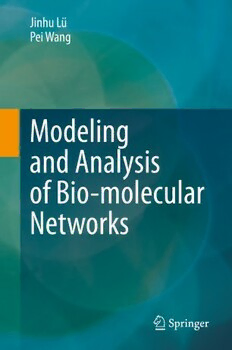
Modeling and Analysis of Bio-molecular Networks PDF
Preview Modeling and Analysis of Bio-molecular Networks
Jinhu Lü Pei Wang Modeling and Analysis of Bio-molecular Networks Modeling and Analysis of Bio-molecular Networks ¨ Jinhu Lu • Pei Wang Modeling and Analysis of Bio-molecular Networks JinhuLu¨ PeiWang SchoolofAutomationScience SchoolofMathematicsandStatistics andElectricalEngineering HenanUniversity StateKeyLaboratoryofSoftware Kaifeng DevelopmentEnvironment Henan,China BeijingAdvancedInnovationCenterforBig DataandBrainComputing BeihangUniversity Beijing,China ISBN978-981-15-9143-3 ISBN978-981-15-9144-0 (eBook) https://doi.org/10.1007/978-981-15-9144-0 ©TheEditor(s)(ifapplicable)andTheAuthor(s),underexclusivelicensetoSpringerNatureSingapore PteLtd.2020 Thisworkissubjecttocopyright.AllrightsaresolelyandexclusivelylicensedbythePublisher,whether thewhole orpart ofthematerial isconcerned, specifically therights oftranslation, reprinting, reuse ofillustrations, recitation, broadcasting, reproductiononmicrofilmsorinanyotherphysicalway,and transmissionorinformationstorageandretrieval,electronicadaptation,computersoftware,orbysimilar ordissimilarmethodologynowknownorhereafterdeveloped. Theuseofgeneraldescriptivenames,registerednames,trademarks,servicemarks,etc.inthispublication doesnotimply,evenintheabsenceofaspecificstatement,thatsuchnamesareexemptfromtherelevant protectivelawsandregulationsandthereforefreeforgeneraluse. Thepublisher,theauthors,andtheeditorsaresafetoassumethattheadviceandinformationinthisbook arebelievedtobetrueandaccurateatthedateofpublication.Neitherthepublishernortheauthorsor theeditorsgiveawarranty,expressedorimplied,withrespecttothematerialcontainedhereinorforany errorsoromissionsthatmayhavebeenmade.Thepublisherremainsneutralwithregardtojurisdictional claimsinpublishedmapsandinstitutionalaffiliations. ThisSpringerimprintispublishedbytheregisteredcompanySpringerNatureSingaporePteLtd. The registered company address is: 152 Beach Road, #21-01/04 Gateway East, Singapore 189721, Singapore Wededicatethisbooktoourfamiliesfortheir patience,loveandsupportover theyears. Preface Systems biology is an interdisciplinary scientific area, which aims at system- level understanding of biological systems. It applies mathematical modeling, as well as computational and statistical analysis techniques to explore complex biological systems. Biological systems can be described by different levels of bio-molecularnetworks, which include gene regulatory networks, protein–protein interaction networks, metabolic networks, signal transduction networks, gene co- expression networks, etc. Different networks contain different biological entities andinteractiverelationships.Theinvestigationsonbio-molecularnetworkscanhelp us to understand the origin, development, and evolution of life phenomena at the systemslevel.Theycanalso provideinsightsaswellas real-worldapplicationsto medicineandlifesciences. This book aims to introduce the mathematical modeling, as well as dynamical andstatistical analysison severaltypicalbio-molecularnetworks.We will discuss thetopicsonthereconstructionofbio-molecularnetworks,mathematicalmodeling methodsforgeneregulatorynetworks,dynamicalanalysisofseveralsimplegenetic circuits(alsowellknownasnetworkmotifs)aswellasstatisticalanalysisonsome large-scalebio-molecularnetworks. Finally, we also introducethe readersa focus research field that is full of opportunities and challenges—data-driven statistical approaches for omics data analysis. The detailed organization of the book is as follows. In Chap.1, we introduce the related backgrounds of this book, where we review the basic concepts and discuss the brief history of systems biology and thecomplexnetworksscience.Moreover,weintroducesometraditionalmetricsfor complexnetworksand statistical analysismethodsforpracticalproblems.Finally, weintroducesomesoftwaretoolstoperformdynamicalandstatisticalanalysis,as wellastovisualizecomplexdata. In Chap.2, we introduce some methods for reconstructing bio-molecular net- works.Fourapproachesforbio-molecularnetworksreconstructionwerediscussed, namely: (1) construction of bio-molecular networks based on online databases; (2)generatingbio-molecularnetworksthroughartificialalgorithmsthatmimicthe general features of real-world networks, such as those based on the duplication vii viii Preface and divergence mechanisms; (3) inferring bio-molecular networks via various mathematical and statistical models based on behavioral data of bio-molecules; and (4) topologyidentification based on dynamicalsystem theory.We summarize some online databases, various artificial algorithms, mathematical and statistical methods to reconstruct each type of bio-molecular networks. The reconstruction ofbio-molecularnetworksfacilitatesthefurthermathematicalmodeling,dynamical andstatisticalanalysisonthem. Chapter 3 deals with the mathematical modeling and dynamical analysis of severalsimplegeneticcircuits.Thewholebio-molecularnetworksformodelorgan- isms are too complex,which have hindered our understandingof them. However, it was found that real-world bio-molecular networks consist of network motifs. Networkmotifsarethosesimplecircuitsthatappearedfarfrequentlythanthatinits randomizedcounterparts.Theinvestigationsonnetworkmotifsarethefirststepto systems-levelexploration.Throughmathematicalmodelinganddynamicalanalysis, weclassifythestructuraladvantagesofseveralsimplecircuits.InChaps.4and5,we overviewanddiscussthemodelinganddynamicalanalysisofseveralcoupledand large-sizedgeneregulatorynetworks,whichgraduallypromoteourexplorationsof bio-molecularnetworkstosystemslevel. Based on statistical analysis and the duplication-divergencemodel, we clarify severalevolutionarymechanismsofnetworkmotifsinundirectedproteininteraction networks in Chap.6. In Chaps.7 and 8, for large-scale bio-molecular networks, we introduce some methods on the identification of importantnodes (also known as gene prioritization)in biologicalnetworksand clarify the statistical featuresof some functionalgenes in large-scale human protein–proteininteraction networks. Chapter 9 deals with the topic of data-driven approachesfor omics data analysis, and some classical methods in this area have been introduced. Especially, we summarized some typical statistical models with different penalization terms (for differentpurposesduringdataanalysis). The topics discussed in this book cover four aspects: bio-molecular network reconstruction; mathematical modeling and dynamical analysis of bio-molecular networks;statisticalanalysisofbio-molecularnetworks;data-drivenmathematical modeling and statistical analysis of biological systems. Some of the methods introducedin this bookare adaptedfrom our publishedpapers.This bookhas the followingmerits: 1. Introducesvariousapproachestoreconstructbio-molecularnetworks. 2. Covers the analysis of various networks ranging from simple circuits, middle- sizednetworks,tolarge-scalebio-molecularnetworks. 3. Introduces various dynamical and statistical analysis tools for gene regulatory networksandproteininteractionnetworks. The expected audience of this book are undergraduates, graduates, and researcherswhoareinterestedinsystemsbiology,dynamicalsystems,andcomplex networks. Prerequisites needed to understand this book include complex network theory, multivariate statistical analysis theory, linear algebra, matrix theory, and theoriesofdynamicalsystems. Preface ix Due to the festinate time and limited knowledgeof the authors, some mistakes and errors in the book are unavoidable. Thus, we welcome to all readers to bring toourattentionanyerrorstheymayfindinthebookandalsogivesuggestionsfor adding new material to improve this book. We hope that this book can help our audienceduringtheirexplorationofthetruthofnature. Beijing,China JinhuLü Kaifeng,China PeiWang May2020 Acknowledgments We acknowledgemany people who have contributed in various ways to the com- pletionofthisbook.Firstofall,Iwouldliketothankmanyacademicpredecessors for their long-term academic guidance, support and help, including the following academicians: Prof. Lei Guo (CAS), Prof. Bohu Li (BAUU), Prof. Weimin Bao (BAUU),Prof.JinpengHuai(BAUU),Prof.JianchengFang(BAUU),Prof.Zhiming Zheng (BAUU), Prof. Wei Li (BAUU), Prof. Jun Zhang (BIT), Prof. Jifeng He (ECNU),Prof.JianhuaLu(TsinghuaU),Prof.HaoYing(CAMS),Prof.WeiWang (CASC),Prof.JieJiang(CASC),Prof.ZhongbenXu(XJTU),Prof.XiaohongGuan (XJTU),Prof.TieniuTan(CAS)andProf.GuangrenDuan(HIT).Sorry,Icanonly mentionafewofthemduetothespacelimitation. WealsowanttoexpressourappreciationtoProfessorJun-anLuattheSchoolof MathematicsandStatistics,WuhanUniversity,ProfessorXinghuoYuattheSchool ofElectricalandComputerEngineering,RMITUniversity,andProfessorTianshou ZhouattheSunYat-senUniversityfordiscussionofsomecontentsinthisbook.We thankShuangXu,MingqiuLi,PeipeiHuang,CanWei,QiongXu,LinglingWang, Chunfang Liu, Shunjie Chen, and Lixin Li for their help during the preparation of the book. Dr. Shuang Xu has contributed to some contents in Chaps.2 and 7. Dr.HaiboGu,QiongXu,andLinglingWanghavecontributedtohelpustoapply fortherightsandpermissionstoreusesomefiguresandcontentsofsomepublished papers.Wearealsothankfulforthesupportandencouragementfromourcolleagues andfamilies. ThisworkwassupportedinpartbytheNationalKeyResearchandDevelopment ProgramofChinaunderGrants2016YFB0800401,inpartbytheNationalNatural ScienceFoundationofChinaunder61532020and61773153.Itwasalsosponsored byNaturalScienceFoundationofHenanundergrant202300410045,theProgram for Science and TechnologyInnovationTalents in Universities of Henan Province under grant 20HASTIT025, and the Training Plan of Young Key Teachers in CollegesandUniversitiesofHenanProvinceundergrant2018GGJS021. xi Contents 1 IntroductionandPreliminaries............................................. 1 1.1 SystemsBiology ........................................................ 1 1.1.1 Overviews....................................................... 1 1.1.2 Developments................................................... 3 1.1.3 ImplicationsandApplications ................................. 4 1.2 ComplexNetworks...................................................... 6 1.2.1 Overviews....................................................... 6 1.2.2 MathematicalDescription...................................... 7 1.2.3 FourTypesofNetworks........................................ 7 1.2.4 StatisticalMetricsofNetworks ................................ 14 1.2.5 DatasetsforReal-WorldComplexNetworks.................. 19 1.3 CentralDogmaofMolecularBiology ................................. 23 1.4 Bio-MolecularNetworks ............................................... 24 1.5 SeveralStatisticalMethods............................................. 25 1.5.1 DescriptiveStatistics ........................................... 25 1.5.2 ClusterAnalysis ................................................ 29 1.5.3 PrincipalComponentAnalysis................................. 33 1.6 SoftwareforNetworkVisualizationandAnalysis..................... 34 1.6.1 Pajek............................................................. 34 1.6.2 Gephi............................................................ 34 1.6.3 Cytoscape ....................................................... 35 1.6.4 MATLABPackagesandOthers................................ 35 1.7 SoftwareforStatisticalandDynamicalAnalysis...................... 38 1.7.1 SAS.............................................................. 38 1.7.2 SPSS............................................................. 38 1.7.3 MATLAB ....................................................... 39 1.7.4 R................................................................. 40 1.7.5 SomeOtherSoftware........................................... 41 1.8 OrganizationoftheBook............................................... 43 References..................................................................... 44 xiii
